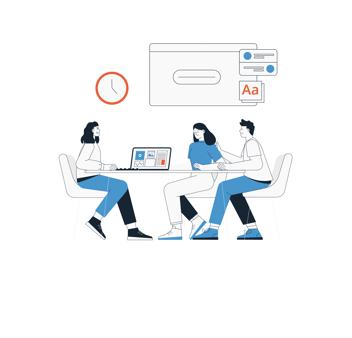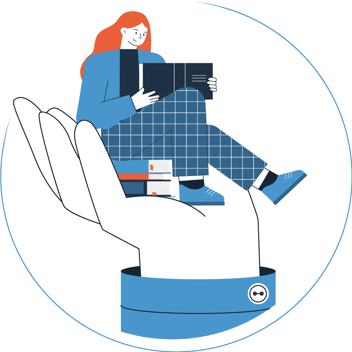
Backpacks are full, hallways are echoing with noise, and the drop-off zone is once again a battlefield - it's the start of another school year and, as educators, you already know there's an endless amount of work happening 'behind the scenes' to ensure classes and students are set up for success.
However, whilst you've probably spent countless weeks planning, organising, and strategising, students aren't generally involved in this process. With everything from their daily schedule to their clothes planned out for them, students are often swept along on their education journey rather than steering their own direction.
So, what can school leaders do to help students take charge of their learning? Support them in setting their own individual goals, and be there to help students achieve them.
A new year is a perfect time to start students on this journey, so if you're not sure how to incorporate goal setting into your school's pedagogy, or you're not sure about how this can benefit student learning and wellbeing, read on for our breakdown of the positive impact goal setting can have on various student outcomes, and our tips for putting it into practice.
Why Set Goals?
It may sound too good to be true, but numerous studies have shown that goal setting can positively affect a range of areas, from academic achievement to class participation.
In the NSW Department of Education's Guide to Growth Goal Setting, results from over a decade of research shows that goal setting is positively associated with:
- Educational aspirations
- Test effort, homework completion and learning strategies
- Class participation, cooperation, and relationships
- Enjoyment of school, and
- Higher levels of literacy and numeracy.
Importantly, evidence indicates that goal setting can be an effective strategy for a wide range of students, whether to assist academically at-risk students or to provide a challenge for high-ability learners.
The VIC Department of Education considers goal setting a crucial part of their approach to high-ability learners, whilst the NSW Education guide found that goal setting:
- Had an especially positive effect for the aspirations of lower achieving students
- Decreased differences in school attendance between students from low- and from high-socioeconomic backgrounds. (NSW Department of Education, p.9)
By setting their own, achievable goals, students become active drivers of their own learning and get a boost of confidence when each goal is met, helping them to better see the merits of their hard work.
However, not every goal is equally effective. In the next section, we outline some key considerations when guiding students to set effective goals.
What Makes an Effective Goal?
A number of elements need to come together to make a goal effective. You may already be familiar with the SMART framework, which requires goals to be Specific, Measurable, Achievable, Relevant, and Timely. This framework is a great starting point, but those are only some of the elements involved in making goal setting as effective as possible.
There's been substantial research into this area, with evidence suggesting the below mix of factors can have a significant impact on whether a goal is effective:

1. Positive and Focused on Self-Improvement
To be most effective, a student's goals should be positive and focus on self-improvement, rather than competing with their peers.
Competition can be motivating in specific contexts, but tends to only benefit the students that are 'winning', having the opposite effect on students who don't perform as well. The same is true of 'negative' goals, which put the focus on a student's mistakes rather than giving a goal to work towards.
|
Competitive
|
Negative
|
Self-Improvement
|
|
"I will get the highest grade in class on the next test."
|
"I won't make as many mistakes on my next test."
|
"I will get more questions right on my next test than last time."
|
2. Specific and Measurable

Vague goals aren't helpful for teachers or students. A specific, measurable goal allows students to plan how they'll achieve it and plot their progress towards the goal.
In fact, "students with specific goals have been shown to improve their skills at a higher rate than students with general goals, and to be more confident in them." (NSW Department of Education, p.12)
Similarly, if a goal isn't measurable, it will be difficult for students to know how far away they are from achieving it, and harder for teachers to give feedback on their progress.
|
Vague
|
Specific
|
Measurable
|
|
"I will study more."
|
"I will use practice exams to study for maths."
|
"I will complete 3 practice exams before my final test."
|
3. Challenging (but Achievable)
Goals should present a challenge to students, to encourage self-improvement, increase confidence, and give them something to work towards.
Finding this balance is an important step, as an easy goal will do little for a student's motivation or sense of achievement but failing to achieve a goal can negatively impact student confidence.
Goals should be ambitious enough to require effort to complete, whilst ensuring that they’re still realistically achievable.
Whether a goal is too easy, too challenging or just right will depend on the individual student. This should be determined based on their prior performance, abilities, and whether they have a viable plan for achieving the goal.
For a student who is typically achieving high C’s in Geography class, the below example may be applicable:
|
Too easy
|
Challenging
|
Too Challenging
|
|
"I will get a C in Geography again this term."
|
"I will get a B in Geography this term."
|
"I will get an A in Geography this term."
|
If your school uses a learning analytics system, this can help both students and teachers to make more informed decisions by giving easy access to previous academic results and performance data.
4. Time-Bound

There should be a defined time period present in each goal, and ideally, that time period should be in the not-too-distant future.
"Short-term goals are more effective than longer-term goals because they provide more specific guidance on the actions required for success and more immediate feedback on progress." (NSW Department of Education, p.13)
Whilst longer-term goals can be effective, they work best when additionally broken down into smaller short-term goals. This can help make the goal more manageable and makes it easier to quickly identify where there may be issues or where students may need support.
|
Not Time-Bound
|
Long-Term Goal
|
Short-Term Goal
|
|
"I will finish my French workbook."
|
"I will finish my French workbook by the end of the term."
|
"I will complete a chapter of my French workbook this week."
|
5. Process/Mastery vs Outcome/Performance
Goals can be broadly split into two categories, commonly referred to as 'mastery' and 'performance' goals.
A performance goal is based on the outcome of a specific task – such as getting an 'A' on an upcoming exam. A mastery goal is concerned more with the process of getting there – with greater emphasis placed on acquiring new knowledge or skills, rather than proving the new knowledge or skills externally.
|
Performance
|
Mastery
|
|
"I will get an A in the upcoming Biology exam."
|
"I will learn what each organ does in the human body."
|
In the example above, it is clear from the mastery goal what the student will need to do to achieve it. Even if they fall short of an A in the exam, they still have an opportunity to achieve the goal by going back over their work and learning from their mistakes.
Whilst neither type is explicitly good or bad, research suggests that performance-based goals can "lead to students avoiding challenges if they are overly concerned about performing as well as other students." (American Psychological Association, p.17)
This is a common theme across research into performance-based goals, where "learning is viewed only as a way to achieve a desired goal" and "a person's self-worth is determined by a perception of an individual's ability to perform" (Goal Setting and Student Achievement: A Longitudinal Study, p.154) whilst research indicates that students with mastery goals are more willing to "take risks and learn from their mistakes." (Marilla D. Svinicki, p.1)
Understanding the difference can help better inform your school's goal setting strategy, and the way that teachers support each student’s goals.
Supporting Student Goals
With a greater understanding of what types of goals are effective for student achievement, and why, it's time to figure out how educators can best make use of them in a school setting.
Students could work with their teachers to set goals for individual classes or submit more general goal worksheets as part of their pastoral care activities. For younger students, it may be helpful to provide a list of examples or common goals that students can pick from or use to create their own.
Whilst teachers are a fantastic support in this area, able to act as a sounding board for students’ ideas and there to offer advice on whether goals are effective and achievable, it’s important that students are still setting their own goals, rather than having goals set for them.
For schools using the Learning Analytics Suite, the Academic Mentoring module allows schools to set up custom goal setting structures for your entire school or individual cohorts. Here, students can see their past and present performance as they set goals, reflect on their learning strategies, and submit their pathway plans to an assigned mentor for feedback.
For best effects, students should be provided with regular feedback on their progress. Monitoring student goals and providing support where they may be struggling is a crucial step in ensuring students are achieving the goals set for themselves, with research showing that "students who receive feedback on their goal progress improve more, are more confident in their skills and are more accurate in assessing their abilities." (NSW Department of Education, p.13)
If students are finding it difficult to keep on top of various goals as the term ramps up, or staff and parents are having trouble monitoring whether students are on track across their classes, consider using a system that supports student goal setting. Depending on the software in place at your school, you may already have access to a solution that's not being well utilised, so investigate what could already be available.
However you choose to implement goal setting at your school, the benefits to student confidence and achievement make it a worthwhile endeavour.
Click below to access the full brochure if you'd like to know more about the Academic Mentoring module.





